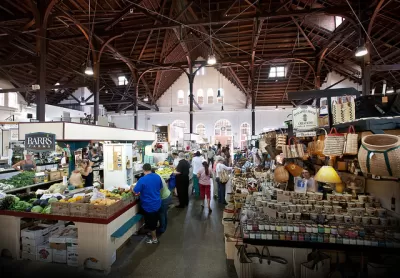Public food markets can be key centers of urban commerce and social life. Late last year, a brainstorming event in London considered how they might evolve to accommodate modern lifestyles and technologies.

More permanent than farmers' markets (though they can assume that role), urban food markets like London's Borough Market and Seattle's Pike Place offer counterpoints to the supermarket mainstream. Louise Marston reports on a event that took place late last year in Borough Market, bringing together "chefs, designers, policy makers, academics and market-goers [...] to explore ideas about what the market of the future might look like."
Marston writes, "The future of food is often treated either as an economic future - a future industry, with associated employment patterns and distribution routes. Or it is forecast as a global, ethical future - a looming crisis of growing population colliding with a growing preference for meat and processed food." Event participants considered a more holistic vision: food as an expression of community.
"There was also a desire to preserve the market as a meeting place, a place of conviviality. Some people wanted to emphasise the role of the market as a place for bartering, exchange and in capturing the full life-cycle of food, including its growing and waste."
Discussion also took place about how the public market—seen as something of a throwback—can be improved by 21st-century technologies. "Drones, hovercraft, helicopters and electric vehicles were all suggested as new ways for food to make its way to and from the market."
FULL STORY: The Future of the Urban Food Market

Alabama: Trump Terminates Settlements for Black Communities Harmed By Raw Sewage
Trump deemed the landmark civil rights agreement “illegal DEI and environmental justice policy.”

Planetizen Federal Action Tracker
A weekly monitor of how Trump’s orders and actions are impacting planners and planning in America.

The 120 Year Old Tiny Home Villages That Sheltered San Francisco’s Earthquake Refugees
More than a century ago, San Francisco mobilized to house thousands of residents displaced by the 1906 earthquake. Could their strategy offer a model for the present?

In Both Crashes and Crime, Public Transportation is Far Safer than Driving
Contrary to popular assumptions, public transportation has far lower crash and crime rates than automobile travel. For safer communities, improve and encourage transit travel.

Report: Zoning Reforms Should Complement Nashville’s Ambitious Transit Plan
Without reform, restrictive zoning codes will limit the impact of the city’s planned transit expansion and could exclude some of the residents who depend on transit the most.

Judge Orders Release of Frozen IRA, IIJA Funding
The decision is a victory for environmental groups who charged that freezing funds for critical infrastructure and disaster response programs caused “real and irreparable harm” to communities.
Urban Design for Planners 1: Software Tools
This six-course series explores essential urban design concepts using open source software and equips planners with the tools they need to participate fully in the urban design process.
Planning for Universal Design
Learn the tools for implementing Universal Design in planning regulations.
Clanton & Associates, Inc.
Jessamine County Fiscal Court
Institute for Housing and Urban Development Studies (IHS)
City of Grandview
Harvard GSD Executive Education
Toledo-Lucas County Plan Commissions
Salt Lake City
NYU Wagner Graduate School of Public Service



























